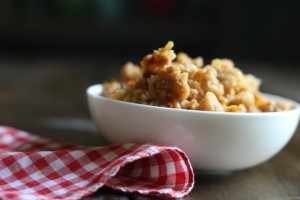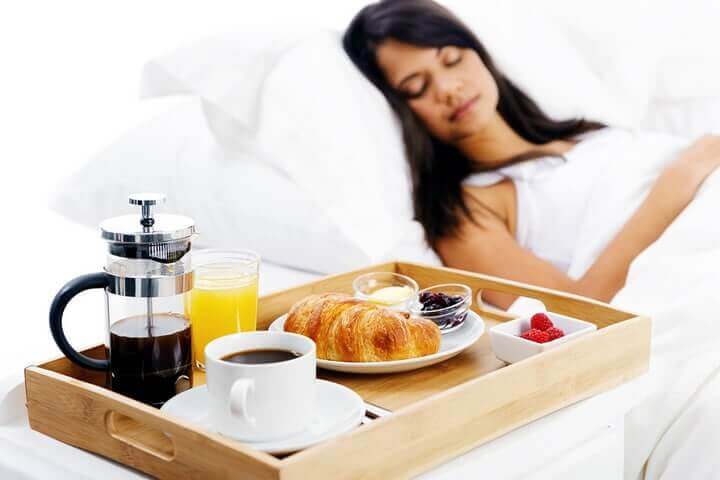
After being wrongly accused for generations, lard is finally making a comeback alongside tallow as a healthy, traditional fat.
If you’ve put off rendering your own because you worried it would take oodles of time, I have good news. It’s actually very easy, and today as part of our real food basics series I’m going to show you how.
WHY I ♥ LARD
Curious about the benefits of this under-appreciated fat? Here are my top three:
1. It’s Rich In The “Happiness Vitamin”
Next to cod liver oil, lard is the second richest source of Vitamin D. (1) (2) According to Sally Fallon, author of Nourishing Traditions, one tablespoon of lard obtained from pastured pigs has been found to contain up to 1,100 IU of Vitamin D.
Why is this important? Because as I mention in this article on the benefits of sunshine, ““At least 1,000 different genes governing virtually every tissue in the body.” (3)
2. It’s Heart Healthy
Yes, I’m serious. Lard is about 45% oleic acid, a monounsaturated fat also found in olive oil. Monounsaturated fats “are responsible for lowering LDL levels while leaving HDL (‘good’) cholesterol levels alone.” (4) It also contains saturated fat, which even TIME Magazine now says is beneficial.
3. It’s Affordable & Sustainable
Lard is much more affordable than coconut oil, olive oil and other healthy fats, and it can be sustainably accessed in most areas.
“Pigs are easily adaptable animals that can thrive nearly everywhere. Raising pastured hogs is a practice that produces a sustainable source of meat while improving the health of the environment. By rooting and foraging, hogs help to turn over topsoil and naturally fertilize the ground.” (5)
It’s Versatile
Lard has a high smoke point (370F) that makes it great for frying, and it’s unique composition also makes it a dream to bake with.
Lard is often the “secret” ingredient behind State Fair blue ribbon pies – if you’ve never experienced the light, flaky texture it imparts you need to put it on your bucket list. But maybe you’re wondering . . .
What Kind Of Lard Should I Use?
Great question! Toxins such as antibiotics that are fed to factory-farmed pigs accumulate in their fat stores, so it’s very important to source your pork fat from healthy, pastured animals. Plus, pastured animals have higher Vitamin D stores.

How To Render Lard In A Crock Pot
How to Render Lard In A Crockpot
Equipment
- Slow cooker (I use this one)
Ingredients
- pastured pork fat (If you can't find pastured pork fat locally, you can find it online here)
- ¼ cup water (spring or filtered)
Instructions
Step 1: Cut or grind the fat into small pieces
- Trim away any pieces of meat or blood as you go. When I first started making lard I was very fastidious about cutting away every tiny bit that had color. There's not really any need to do that - just get the big stuff.
Step 2: Place fat in slow cooker
- Add 1/4 cup of water to the slow cooker to prevent the fat from burning - it will evaporate during the rendering process.
Step 4: Check progress and stir
- After an hour, you'll start to see some liquid in the bottom of the slow cooker. Progress! Give the pot a stir every once in awhile until the fat is completely melted.
Step 5: Remove from slow cooker
- When the lard is ready you’ll see brown bits of “cracklings” resting on the bottom of the pot with a layer of fat over them. Time to turn off the slow cooker and prepare to strain.
Step 6: Strain lard
- Pour the contents of your slow cooker over a cheesecloth lined colander to separate the lard from the cracklings.
Step 7: Pour into storage containers
- Pour the lard into jars and set aside to cool on a countertop or in the fridge.
Step 8: Use remaining bits
- Don’t throw the browned bits away! You can use them to make cracklings. (See below for instructions)
Bonus Step: How To Make Cracklings
- To make cracklings, simply sprinkle the leftover brown bits with a little salt and put them in a pan set over medium heat.
- As they cook some of the excess fat will melt away and they’ll become crispy. They’re called cracklings because they often pop and sizzle as they cook.
- Once they’re crispy remove them from the pan and serve. They’re delicious with a little hot sauce and a spritz of lime.
- Craig Fear. 7 Reasons Why You Should Eat Lard
- Collis, Jane (2014) Vitamin D and mortality: meta-analysis of individual participant data from a large consortium of cohort studies from Europe and the United States
- BBC (2019) Sun’s blood pressure benefits ‘may outdo cancer risks’
- Main, Emily (2012) Why You Should Eat More Fat
- Geersten, Lauren (2014) 10 Reasons To Bring Lard Back













